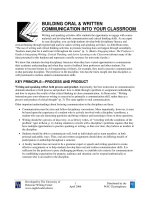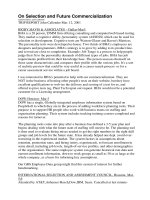Tài liệu BUILDING ORAL AND WRITTEN COMMUNICATION INTO YOUR CLASSROOM doc
Bạn đang xem bản rút gọn của tài liệu. Xem và tải ngay bản đầy đủ của tài liệu tại đây (45.05 KB, 3 trang )
BUILDING ORAL & WRITTEN
COMMUNICATION INTO YOUR CLASSROOM
Developed by The University of
Delaware Writing Center
www.english.udel.edu/wc
1
April 2006
Distributed by the
WAC Clearinghouse
Writing and speaking activities offer students the opportunity to engage with course
materials and develop both communication and critical thinking skills. As an expert
in your discipline, you can help students develop both disciplinary literacy and
critical thinking through regular high and low stakes writing and speaking activities. As John Bean notes,
“The use of writing and critical thinking activities to promote learning does not happen through serendipity.
Teachers must plan for it and foster it throughout the course” (p. 1). (Bean’s Engaging Ideas: The Professor’s
Guide to Integrating Writing, Critical Thinking, and Active Learning in the Classroom informs many of the
ideas presented in this handout and represents a terrific resource for university faculty.)
We know that students develop disciplinary literacies when they have varied opportunities to communicate
their academic understanding and when they receive feedback from professors and other students. For
students to become literate in civil engineering or history, for example, they need to practice communication
in that particular discipline. The professor in the discipline, who has the truest insight into that discipline, is
well positioned to nurture student communication skills.
KEY PRINCIPLE—PROCESS AND PRODUCT
Writing and speaking reflect both process and product. Importantly, the best instruction in communication
demands attention to both process and product: how to think through a problem or assignment methodically
and how to express the results of that critical thinking in clear communication. As Bean notes, “Writing
instruction goes sour whenever writing is conceived as primarily a communication skill, rather than as a
process and product of critical thought” (p. 3). The same applies to oral communication.
Other important understandings about fostering communication in the disciplines are these:
• Communication must be clear and follow disciplinary conventions. More importantly, however, it must
be based upon the experience of a student who is actively involved with a discipline’s problems, a
student who can ask interesting questions and bring evidence and reasoning to bear on those questions.
• Writing should be a process of discovery, or as Dewey writes, of “wrestling with the conditions of the
problem” (qtd. in Bean, p. 4).
Asking students to wrestle with a discipline’s problems requires that they
have multiple opportunities to practice speaking or writing, so that over time, they behave as insiders to
the discipline.
• Students should be able to communicate well, both as individuals and as team members, in both
personal and public ways. Thus, oral and written assignments should draw on differing models of
participation or authorship throughout a semester.
• A faculty member does not need to be a grammar expert or speech and writing specialist to create
effective assignments or to help students develop their oral and written communication skills. It is
sufficient for the professor to pose challenging problems; to establish rich contexts for communication
by establishing expectations for purpose, audience and situation; and to respond authentically as
someone who is an insider to the discipline.
DEVELOPING COMMUNICATION ACTIVITIES FOR A SPECIFIC CLASS
You may decide to work within a single course to integrate writing and speaking activities. Here are some
approaches:
• Create problem-focused writing and speaking assignments: Develop genuine problems specific to
your field (the Problem-Based Learning or PBL approach). You might choose to use hypothetical or
real-world audiences. Work for integration of team communication skills, information and research
skills, and written and oral presentation skills.
• Develop portfolios: Consider asking students to develop a portfolio of writing—you look at ongoing
writing, and students work with peers throughout the semester, turning in their best work at semester’s
end. Students might choose assignments from a menu of options that would fulfill your course
requirements.
• Incorporate frequent nongraded or low stakes writing into your syllabus, so students can see writing
as a tool for thinking, not simply another hurdle. Your focus here should be on encouraging students’
critical thinking, not on evaluating the grammar of their prose. Bean devotes a full chapter to these
kinds of exploratory activities and encourages their use: “Exploratory writing is often inchoate because
the writer has to sort through tangled strands of ideas that need to be written out and reflected on before
they can be untangled and organized. Worrying about spelling and grammar when you are trying to
discover and clarify ideas can shut down any writer’s creative energy. Exploratory writing is messy
because thought is messy” (p. 101).
Examples of low stakes writing could include the following:
Prewriting for more formal assignments—quick notes, lists, reflections, freewriting, taking
an opposing viewpoint.
Metacognitive writing—students reflecting on what they have learned, what challenges a
particular concept poses, where they feel they have made significant progress, how they plan
to solve a particular problem, where they went wrong on an exam, etc. These can be typed
one pagers or short reflections on notecards.
Opportunities to paraphrase course material, to make connections between concepts or
lectures, to hypothesize, to make mistakes where they don’t count, and, most importantly, to
raise questions.
Minutewrites (also called microthemes) that students either bring to class or write in the first
minute or two of class on notecards. In a minutewrite, students can pose questions for the
day’s discussion or summarize the previous night’s reading. To add an oral component, they
can exchange responses and have a short discussion with each other. They can then add what
came out of the discussion to their notecards before turning them in. You can collect these
and share one or two with the class or read them quickly after class to assess students’
understanding or misunderstanding.
Reading journals allow students to summarize outside-of-class reading and ask or answer
key questions. Some professors prefer a double-column entry, with the summary of key points
on the left and the student’s reaction, evaluation, criticism, or extension of those ideas on the
right. Such journals can be quickly graded with checkmarks or a few points. They can stand
alone or lead to a lengthier paper, such as a review of the literature.
• Develop a sequence of assignments that build or scaffold upon each other, rather than one long paper
due at semester’s end. Assignments sequenced throughout the semester allow students opportunities to
accommodate their growing writing skills and knowledge of course content. Sometimes the same
Developed by The University of
Delaware Writing Center
www.english.udel.edu/wc
2
April 2006
Distributed by the
WAC Clearinghouse
background research can be written first as general exposition (as in a briefing report) but then
reworked for another purpose (such as a brochure on behalf of a community action committee).
Remember that some cognitive tasks are more difficult than others, so assignments should scaffold on
students’ developing expertise. For students, recalling facts or demonstrating comprehension is much
simpler than synthesizing or evaluating. A student who writes an excellent summary of a journal article
may write a much weaker paper when asked to synthesize several journal articles. With writing and
speaking activities, begin the semester with the easier tasks and highlight the escalating demands.
• Create a communication-intensive WebCT class: Integrate uses of technology to support
development of communication skills. Integrate regular use of chat, discussion boards, posted student
work, team presentations, peer review, or other activities supported by WebCT.
DEVELOPING COMMUNICATION ACTIVITIES IN THE DEPARTMENT
You may decide to undertake a project at the department or college level focused on integrating
communication skills into the discipline. Your project might take one of the following forms:
• Assess current practices: How often do students write or speak in the contexts of current instruction in
your major? What sorts of variety characterize classroom instruction? How are professors managing to
work with student writing and speaking in their various courses?
• Assess the needs of working graduates of your program: What kinds of communication skills are
most necessary for graduates of your program? Do graduates feel as though they were equipped with
the right skill set? What would they recommend for improving your curriculum? How well connected
are current curricular experiences to the needs of graduates?
• Launch a portfolio initiative in the department to gauge student preparedness for graduate school or
for working in the field (and to give students a boost in their job searches). You might plan to assess a
sample of your graduating seniors through portfolios representing written and spoken work.
• Develop an introductory cornerstone course that introduces and socializes students into the
discipline, with an emphasis on research, information sources, reading, writing, and speaking in the
major. Designed for first year students, it could meet the ENGL 110 requirement (and take pressure off
the English Department).
• Design or redesign a capstone course in the major so that students demonstrate their abilities to write,
speak, and use information at professional levels.
• Develop a detailed plan for the integration of writing and speaking across the major core courses.
• Design a pilot project in which your department’s best faculty writers or graduate students, along with
undergraduate Writing Fellows or Writing Center faculty, develop a partnership with the department to
hold faculty training and student workshops on writing and speaking in core classes.
USEFUL SOURCES
Bean, John C. Engaging Ideas: The Professor’s Guide to Integrating Writing, Critical Thinking, and Active
Learning in the Classroom. San Francisco: Jossey-Bass 2001.
The WAC Clearinghouse at Colorado State University has a wealth of resources to support faculty:
The Online Writing Center (OWL) at Purdue University has resources for both students and faculty:
/>Developed by The University of
Delaware Writing Center
www.english.udel.edu/wc
3
April 2006
Distributed by the
WAC Clearinghouse









